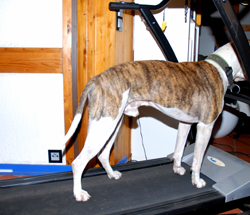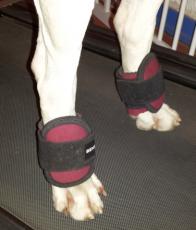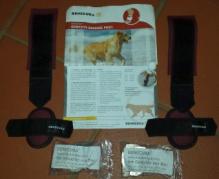
Das Laufband-Training
Das Training auf dem Laufband eignet sich zum Aufbau von Muskulatur und auch als Herz-Kreislauft-Training, dem sogenannten Konditionstraining. Das Training mit einem Laufband wird sehr häufig auch in der Reha eingesetzt um nach einer OP den Muskel wieder aufzubauen und die Gelenke in Bewegung zu halten, hierbei kommen vor allem Unterwasser-Laufbänder zum Einsatz.
Wer sich fragt, welche Rasse auf dem Laufband trainieren kann dem sei gesagt, können kann jeder. Mal im Ernst, die Größe des Hundes spielt keine Rolle, die Größe des Laufbands schon eher. Ein geeignetes Gerät für eine Deutsche Dogge zu finden ist mit Sicherheit schwerer, in diesem Fall ist es sehr wahrscheinlich notwendig ein spezielles Hunde-Laufband (z.B. WT-Metall bietet so etwas an) zu verwenden. Das Training für die in unserem Sport üblichen Rassen ist ohne Probleme auch auf handelsüblichen Laufbändern möglich. Aber man sollte auf JEDEN Fall vor dem Kauf ein paar Test machen und gucken ob der eigene Hund auf das Gerät passt und die Lauffläche nicht zu kurz ist ggf. muss man dann auf ein gebrauchtes Gerät aus einem Fitness-Studio zurückgreifen, da diese in der Regel, breiter und länger sind. Wir nutzen zum Beispiel ein ganz einfaches Laufband für Menschen, ein dazu recht günstiges Model. Unsere Bulldogge kann gut darauf laufen, für unseren Malinois könnte es ein paar Zentimeter länger sein.
Der Hund sollte so trainiert werden, dass er selbstständig auf dem Laufband bleibt. Von anbinden/fixieren halte ich persönlich gar nichts, denn so kann der Hund in einem Notfall auch nicht selbständig herunter. Dennoch nutzt man am Anfang ggf. die Leine um den Hund evtl. zu korrigieren. Für die Gewöhnungsphase kann man auch seitlich Holzbretter als Begrenzung aufstellen bzw. montieren. Ob das etwas hilft kann ich nicht sagen, wir haben diese nicht gebraucht aber die speziellen Hunde-Laufbänder haben so etwas immer dabei, daher gehe ich davon aus, dass es hilfreich sein kann.
Um eines gleich vorweg zu nehmen, diese Trainingsmethode wird zusätzlich zum täglichen Auslauf eingesetzt und ist in keinem Fall der Ersatz für die Spaziergänge oder das Laufen im Freien!!!
Im Prinzip ist dieses Training ganz einfach, wenn der Hund erst einmal an das Laufband gewöhnt ist. Diese Gewöhnung kann sich im Einzelfall schon etwas nervenaufreibend und zeitaufwendig gestallten. Immer daran denken, nie mit Gewalt und immer ganz ruhig, mit viel Geduld und in kleinen Schritten vorgehen ggf. bitte Rat bei einem Tiertrainer einholen. Unter Umständen kann die Gewöhnung schon ein paar Wochen in Anspruch nehmen – die Dauer hängt aber auch vom Charakter des Hundes ab.
Tipp: Beim Üben zeigt sich der Einsatz von Leckerli und Klicker sehr vielversprechend.
Beim Konditionstraining legt der Hund nach seinem Spaziergang einfach eine extra Runde auf dem Laufband ein. Man sollte immer mit einer langsameren Schrittgeschwindigkeit starten und dann langsam die Geschwindigkeit steigern. Eine sinnvolle Endgeschwindigkeit liegt zwischen 8 – 10 Km/h, so dass der Hund im Trab laufen kann. Ob nun 6 oder 10 Km/h eingestellt wird ist zweitrangig, wichtig ist, dass man darauf achtet wie schnell der Hund sich auf dem Laufband bewegt und dass er in der Trab Geschwindigkeit bleibt. Bedenke immer: Je nach Größe des Vierbeiners variiert die eingegebene Geschwindigkeit.
Diese Trainingsmethode mit dem Ziel Konditionsaufbau, ist in der Regel nicht notwendig, wenn man mit seinem Hund Fahrradtouren unternimmt oder mit ihm joggt, ist aber ein absolut tolles Hilfsmittel, wenn man selber mit einem Handicap wie z.B. gebrochenem Fuß unterwegs ist und nicht die üblichen Sachen mit dem Hund unternehmen kann.

Das Muskelaufbautraining auf dem Laufband ist meiner Meinung nach eine der besten Alternativen zum schweren Zugtraining mit Ketten oder Schlitten. Als Hilfsmittel dienen, neben dem Laufband, zwei Gewichtsmanschetten aus der Tier-Reha. Die Gewichte werden immer Paarweise jeweils vorne oder hinten, mittels Neopren-Manschetten, an den Füßen befestigt.
Man kann die Gewichte variieren und allmählich steigern. Am Anfang, startet man mit relativ wenig Gewicht wie z.B. 40 Gramm auf jeder Seite und kann dann bei regelmäßigem Training das Gewicht um 10 Gramm die Woche steigern. Mehr als 2 – 3 mal die Woche sollte man dieses Training nicht machen. Bitte auch immer an die Ruhephasen denken und dem Hund einen Tag Pause zur Regeneration lassen und einfach mal nichts machen! Grundsätzlich empfiehlt es sich, gerade am Anfang, die Gewichte in Abstimmung mit dem Tierphysiotherapeuten auszuwählen.
Man kann die Gewichte variieren und allmählich steigern. Am Anfang, startet man mit relativ wenig Gewicht wie z.B. 40 Gramm auf jeder Seite und kann dann bei regelmäßigem Training das Gewicht um 10 Gramm die Woche steigern. Mehr als 2 – 3 mal die Woche sollte man dieses Training nicht machen. Bitte auch immer an die Ruhephasen denken und dem Hund einen Tag Pause zur Regeneration lassen und einfach mal nichts machen! Grundsätzlich empfiehlt es sich, gerade am Anfang, die Gewichte in Abstimmung mit dem Tierphysiotherapeuten auszuwählen.
 Benecura Gewichts-Bandage Profi
Benecura Gewichts-Bandage ProfiMit den Gewichten kann der Hund auf dem Laufband langsam gehen, eine Lauf- bzw. Trab- Bewegung ist zu vermeiden. Die Geschwindigkeit sollte max 6 km/h, bei einem großen Hund, nicht überschreiten.
Die Dauer kann je nach Trainingsstand variiert werden. Am Anfang empfiehlt es sich, nur ca. 10 min hinten und 10 min vorn zu trainieren. Schrittweise kann man, wie auch beim Gewicht, die Trainingsdauer langsam steigern.
1. Videosequenz Laufband-Training - Beispiel: Gewichte an den Hinterläufen
2. Videosequenz Laufband-Training - Beispiel: versetzte Gewichte:
english version
The treadmill workouts
The training on the treadmill is suitable for building muscle and also as a heart - rebreather training, the so-called fitness training . The workout with a treadmill is very often used in rehabilitation to rebuild after surgery the muscle and to keep the joints moving, this especially underwater treadmills are used.
Who wonders what breed can work out on the treadmill that is said , can anyone can . Seriously , the size of the dog does not matter the size of the treadmill are more likely. To find a suitable device for a German mastiff is heavier for sure , in this case it is very likely need a special dog treadmill ( eg WT- metal has something to ) to use . The training for the usual in our sport races is possible without problems even on commercial treadmills. But you should make EVERY case before buying a few test and see whether their own dog fits on the device and the tread is too short not necessary, you must then on a used unit from a gym to fall back , as these are rule , are wider and longer. We use , for example, a very simple treadmill for people to a reasonably priced model . Our Bulldog may well run out for our Malinois it could be a few inches longer .
The dog should be trained so that it automatically remains on the treadmill . From tie / fix , I personally do not , because then the dog in an emergency, not self down . Nevertheless, if necessary, uses corrected, if necessary at the beginning of the leash to the dog. For the habituation phase can also be laterally Place or install wooden boards as a limitation . Whether that helps a little , I can not say we have not used this but the special dog treadmills have something always there , so I 'm assuming that it can be helpful .
In order to take the same one anticipates this training method is used in addition to daily exercise and in no case is the replacement for walking or running outdoors !
In principle, this training is quite easy if the dog is once accustomed to the treadmill. This habit can be a bit nerve-wracking gestallten and time consuming in some cases. Always remember , never with violence and always very quiet with lots of patience and proceed in small steps , if necessary, please seek advice from an animal trainer . It is possible that habituation can already take a few weeks - but the duration also depends on the character of the dog.
Tip: When practicing the use of treats and clicker shows very promising.
During physical training , the dog shall, after his walk just an extra round on the treadmill one . You should always start with a slower pace and then gradually increase the speed. A reasonable top speed is between 8 - 10 Km / h , so that the dog can run at a trot . Whether 6 or 10 Km / h is set is of secondary importance , it is important that you make sure how fast the dog is moving on the treadmill and that he remains in the speed trot . Always Remember: Depending on the size of the quadruped vary the input speed.
This training method with the aim of building condition , is usually not necessary if his dog is taking bike rides or jogs with him, but is an absolutely great tool if you yourself with a handicap such as broken foot is on the way and can not do the usual stuff with the dog.
The muscle building workout on the treadmill is in my opinion one of the best alternatives to heavy Zugtraining with chains or slide . As an aid , serve next to the treadmill, two ankle weights from the animal rehab . The weights are respectively the front or back , always attached in pairs by means of neoprene cuffs on the feet.
One can vary the weights and gradually increase . In the beginning , you start with relatively little weight such as 40 grams on each side and can then increase the weight by 10 grams with regular training week. More than 2 - 3 times a week you should not do this Training . Please also always think of the periods of rest and let the dog have a day off for regeneration and do anything just once ! It is generally advisable , especially at the beginning , select the weights in consultation with the animal physiotherapist.
One can vary the weights and gradually increase . In the beginning , you start with relatively little weight such as 40 grams on each side and can then increase the weight by 10 grams with regular training week. More than 2 - 3 times a week you should not do this Training . Please also always think of the periods of rest and let the dog have a day off for regeneration and do anything just once ! It is generally advisable , especially at the beginning , select the weights in consultation with the animal physiotherapist.
Benecura weight bandage professional
With the weights , the dog can walk slowly on the treadmill , run or trot movement should be avoided. The speed should be max 6 km / h , not exceeding for a large dog .
The duration can be varied depending on the level of training . In the beginning, it is advisable to train only about 10 minutes behind and 10 minutes ahead. Gradually you can , as well as the weight , increase exercise time slowly.